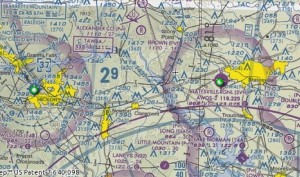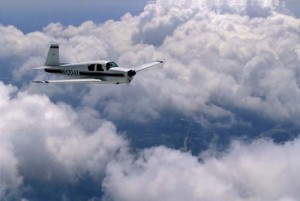It Was a Dark and Stormy Night…
With Hurricane Irene safely behind us, I thought I’d share a story from my pre-airline days, about one of my scariest experiences as a pilot
With Hurricane Irene safely behind us, I thought I’d share a story from my pre-airline days, about one of my scariest experiences as a pilot.
From my logbook, here are my entries for a flight in November 1985. There is only a small space for remarks, so they’re not detailed. But they’re enough to remind me vividly of that day. These entries are verbatim and therefore cryptic:
——————–
11-2 M20C N78959 W09 – McCollum, Kennesaw GA 3.9 hrs w/Paul, Barb. Visit Shavers. LORAN to NC, then VOR; IFR most of time
11-4 M20C N78959 McCollum – Statesville NC 2.0 hrs
Gloomy forecast. Heaviest rain ever!! Engine out @7000’ over Barrett’s Mt due to showers
11-4 M20C N78959 Statesville – LYH 1.3 hrs
Emergency landing @ Statesville, MVFR (thank God!) Try to push on. More showers; Precautionary landing LYH. Stayed @ Holiday Inn
11-5 M20C N78959 LYH-W09 1.3 hrs
Mostly IFR, little rain. Good to be home!!
——————–
Paul is a friend since high school days, and I’m surprised he even went with me on this trip, considering another experience we had flying to the Bahamas several years earlier (a story for another time perhaps). Along with his wife, Barb, we set out to Georgia to visit another high school friend and his wife.
It was a nice visit, and when it came time to return home, I checked the weather. Rain in the forecast, but that’s why the FAA invented the Instrument Rating (which I had). So I felt bullet-proof, and filed for the flight home.
The rain that lay ahead turned out to be some of the heaviest I’ve ever encountered, and it caused flooding that ranks as the second worst in Virginia history. (Go here for a list of the ten worst.)
The airplane we flew was an old 1963 Mooney, which belonged to a student of mine. He let me use it for free whenever I wanted; I just paid for gas. The Mooney is a very nice four-seat plane with little room inside — it’s built for speed.
On the November 4th flight from Georgia, we started encountering rain in North Carolina, which got progressively heavier to the point that the plane actually leaked (rain coming in through seams in the roof and dripping on Barb in the back). It got so loud from the sheer volume of water impacting the plane that it was unlike anything I had experienced in an airplane. I felt more like I was on a submarine, and could barely hear the controller over the headset.
Then the engine just stone cold quit.
The absence of the roar of the engine left us in a small (and oh God, it felt small at that moment), leaky vessel at 7,000 feet, in the heaviest rain I had ever seen. Looking back through the fog of time, it would be silly to think that I could accurately describe all of my emotions and thoughts at that moment, but I distinctly remember a couple of things.
I had two competing thoughts that demanded air time in my brain. One was something along the lines of, “Well, you idiot, this is how you get yourself into Flying magazine, and all the pilots reading your story in the Aftermath section will be tsk, tsking about what a bonehead you were for flying into conditions beyond your capability.” The other thought was a sense of overwhelming guilt at putting my trusting friend and his wife in this situation. I kid you not, the guilt feeling was one of my strongest emotions.
I could feel the effect of adrenaline, and I remember consciously thinking that I had to keep it together for my friends’ sake. I looked at Paul, sitting to the right of me, and he was looking wide-eyed back at me. He knew this was serious, but he was taking his cues from me and I tried hard to give the appearance of calm.
All of the above—the thoughts, the looks—were in the first few seconds after the engine quit. I keyed the mike and told the controller “Washington Center, Mooney 959. We’ve had an engine failure”
I had the radio turned way up so that I could hear the controller, and she responded, “Roger 959, what are your intentions?” This struck me as somewhat humorous at the moment, but I thought it best not to share my amusement with Paul. I simply said, “We need to land.”
Of course, we were going to land, whether we needed to or not. The question was, would we survive the landing?
The controller said, “Roger 959, turn right heading 180 degrees, vectors for Barrett’s Mountain. Current weather at the field: 200 foot overcast, visibility one half mile, heavy thunderstorms. Winds …” I can’t remember the specific winds, but I do remember clearly that it was 200 and a half…classic ILS weather minimums. This was the minimum weather to fly an ILS with an engine running. And I was going to attempt it deadstick!
I should mention that the terrain was mountainous, and the Barrett’s Mountain airport sits at 1,030′ MSL (above sea level). It was not a pretty prospect.
Then, halfway through the turn (because what option did I have but to try?), we popped out of the side of tall cumulus buildups and into clear air. I immediately rolled the wings level and stopped my turn; no way I was going back in the clouds. Ahead were more clouds, but there were gaps and I could see the ground. I would take my chances with an off-airport landing that I could see rather than a deadstick to 200 feet that I couldn’t see. (Note: if we had been another half mile west, we would have completed this turn in the clouds and the outcome of this story would likely have been much different.)
Looking over my left shoulder I looked at the clouds going up to probably over 40,000 feet and extending on a line from the southeast to the northeast as far as I could see. I told Center I was back in VMC (Visual Meteorological Conditions) but I honestly can’t remember anything of what I said. She offered the fact that Statesville, North Carolina was at my 12 o’clock position and 10 miles away.

VFR Sectional chart showing Statesville airport (Barrett's Mountain airport is now apparently a private field named Little Mountain Airport)
I’m not sure what my altitude was at this time (although I was still comfortably above the terrain I could see) or if I could have glided all the way to Statesville. I was delighted with the prospect of just picking an open field. Our chances of living had skyrocketed!
Once clear of the rain, the engine began coughing back to life. Throughout this ordeal, the prop had been turning, windmilling in the slipstream (you really have to work at it to get the prop to actually stop without the engine running). Each time the prop turns it causes the magnetos to fire the spark plugs (two sets in each cylinder for redundancy), so the engine is constantly trying to restart in a case like this.
It turns out the reason for the engine failure was the sheer amount of water being ingested. A combustion engine requires intake air to operate, and the heavy rain was displacing the air, so the engine just quit. I might have been able to avoid the failure by selecting “Alternate Air,” which provides a different pathway for air to reach the engine, bypassing the air filter. Alternate Air is usually selected in cases where the air filter ices up, but could well have worked for this case too…I’ll never know.
Anyway, as the water worked its way through the system, the engine was sputtering, and it finally coughed back to life somewhere around 2,000 feet. By the time I was on final approach at Statesville, it was purring as sweet as ever.
Epilog: Somehow I convinced Paul and Barb to get back in the plane and continue home to Leesburg (W09 was the airport identifier for Leesburg then; now it’s JYO). This really is a testament to my persuasive skills, but it still amazes me 26 years later.
I thought we could stay east of the rain, but I was wrong, and once we started encountering rain on the flight out of Statesville, Paul started pointing down, gesturing that he wanted to get on the ground. So I diverted to Lynchburg, Virginia, where we stayed the night. The approach in to Lynchburg was no piece of cake — right down to a 200 foot ceiling and a half mile visibility in rain showers. You can bet I was watching those engine instruments during approach, and I was really glad to be on the ground…again.
/https://tf-cmsv2-smithsonianmag-media.s3.amazonaws.com/accounts/headshot/Steve-Satre-headshot.jpg)

/https://tf-cmsv2-smithsonianmag-media.s3.amazonaws.com/accounts/headshot/Steve-Satre-headshot.jpg)